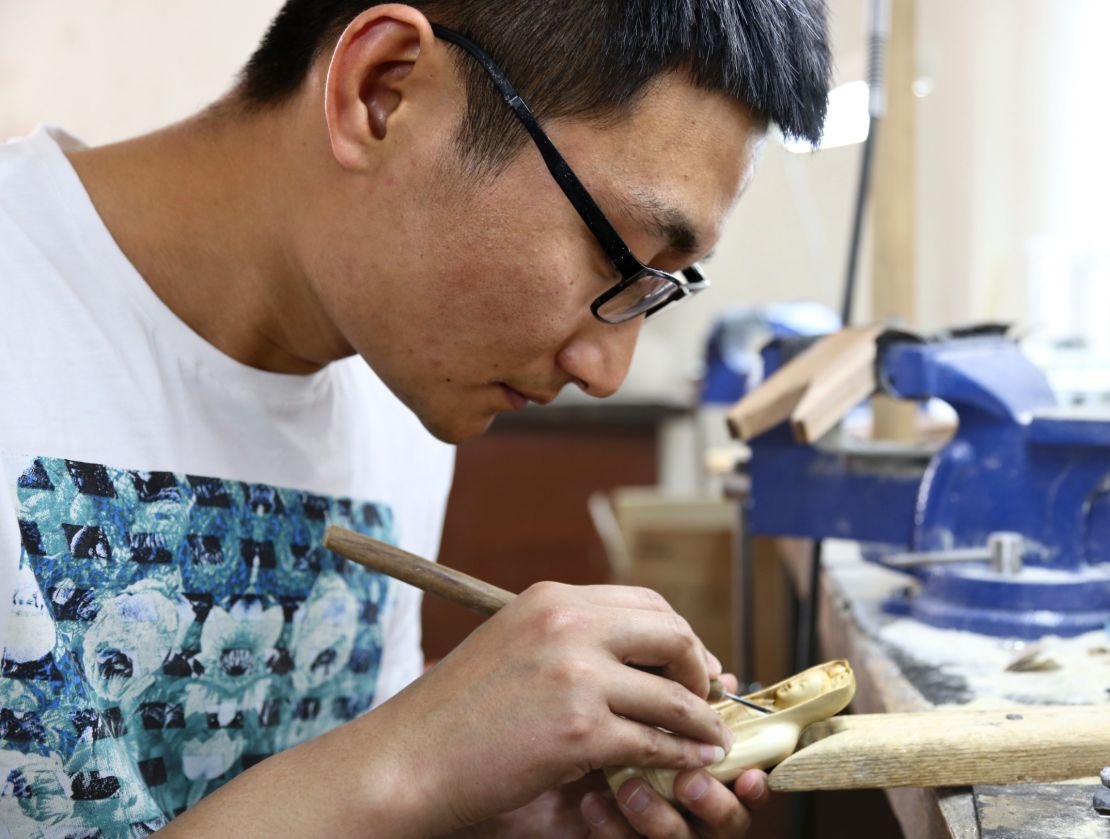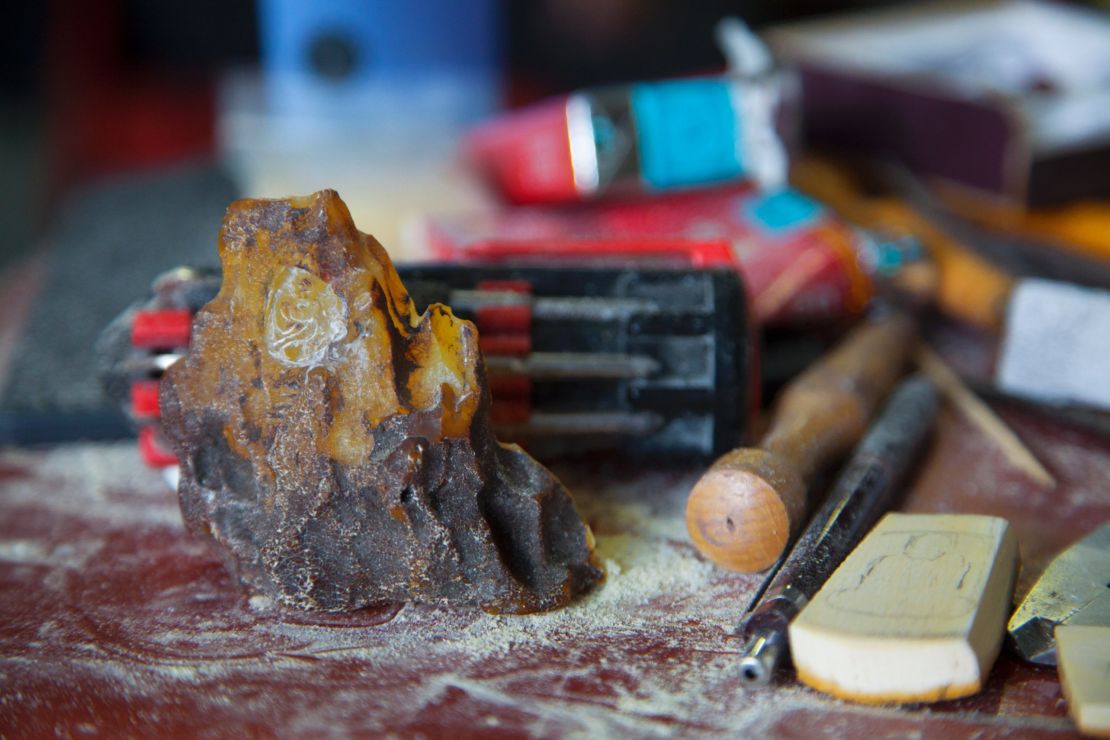Story highlights
Recent bans against ivory trade have resulted in decreased demand
Some regard ivory carving as an endangered art form
Alternative materials, like the use of mammoth tusks, are on the rise
When Li Chunke started carving ivory in 1964, the number of elephants in Africa was still on the rise. Demand for ivory in China was practically non-existent and tusks could be bought for under $7 a kilogram.
Today, this figure is closer to $1,100 – according to research by Save the Elephants.
But while this marks a significant increase over the course of Li’s career, the price of coveted xiangya (elephant teeth) has almost halved over the last 18 months.
An endangered art form?
Conservationists have welcomed the recent drop in demand, attributing it to awareness campaigns and President Xi Jinping’s commitment to abolish the ivory trade in China.
But for 65-year-old Li, these changing attitudes threaten an ancient art form and the livelihoods of many carvers.
“Ivory carving represents Chinese traditional culture” he says, sipping green tea in his small apartment in Beijing.
“Chinese people love it because it is an ancient skill – it’s a practice that belongs to the imperial arts.”
At the state-owned factory where he spent his five-decade career, Li would sculpt everything from small trinkets to full-length tusks adorned with classical scenes.
Hong Kong to phase out ivory trade
Alternative raw materials to ivory
Legal restrictions mean that he is rarely able to keep raw ivory at his home.
Nonetheless, on the far side of his living room I find a small workshop besieged by chisels, drill bits and tools.
Some are electronic, but the majority are simple hand tools – the sort he trained with. From the clutter, Li picks out figurines carved from a variety of different materials.
Ivory’s rare combination of density and smoothness makes it ideal for intricate carving, but there are alternatives. Hippo, narwhal and walrus tusks possess similar qualities.
“When we don’t have ivory, we also use beeswax and agarwood,” he explains.
Li shows me a small horse statuette and an ancient goddess fashioned from a piece of mammoth tusk – an ivory substitute excavated from the Siberian permafrost.
“When we made carvings for export [in the 1960s] the products had to represent Chinese traditional culture – it was merchandise,” he recalls.
“Now I can carve on any theme, including religion and modern life.”

Hong Kong’s illegal ivory trade exposed
Legal vs. illegal ivory trade
Since retiring from the factory in 2013, Li estimates he makes fewer than 10 carvings a year, and can spend as long as two months on a single item.
He appears despondent about elephant poaching and the black market that are now associated with his industry.
“We are legal ivory-carving professionals,” he says. “The ivory we used was from natural deaths. We ought to protect wildlife. I like animals and I’ve kept a puppy as a pet. I find it shocking that elephants are killed by men.”
With the worldwide ban on ivory in 1989, factories like Li’s were able to stay open, as China still permitted domestic trade. A licensing system allowed the continued import of tusks sourced from natural elephant deaths and police seizures.
But the distinction between legal and illegal trade is becoming blurred, say conservationists.
A 2011 investigation by the International Fund for Animal Welfare (IFAW) found that almost 60% of licensed vendors and carving factories in China were involved in black market trade.
A high-profile campaign featuring former basketball star Yao Ming argues that all ivory consumption – even the licensed trade – feeds the cycle of killing.
“Yao Ming’s ‘no buying, no killing’ is only partly right – we still have to think about the inheritance of traditional Chinese culture,” Li says.
“Of course, the raw material can be replaced by alternatives, which is why my students also use woods and jade. But some of the nuances of carving – ones that can only be reflected in ivory – are at risk.”

Rise in demand for mammoth tusks
On the other side of central Beijing, one of Li’s students, Li Jiulong (no relation), leads me into his small, dusty workshop. The 26-year-old shares the space with four other apprentices. A fellow carver sits practicing her technique on a small block of wood, her engravings guided by ink markings.
Work surfaces are arranged in a square, each littered with hand tools for breaking down large chunks of tusk and more accurate electronic ones for finer details.
While his master is old enough to ignore the diminishing demand for ivory, the younger Li must keep his options open.
In addition to his apprenticeship he is also undertaking a master’s degree which sees him working with lacquer – a traditional colored finish applied to wood.
He can obtain ivory through “the proper channels,” but Li spends much of his time carving other materials, including mammoth tusks.
“These tusks have been buried underground for a long time, which can cause cracks and change their color,” he explains, sketching out their differing patterns of grain on a piece of paper. “They would [originally have been] white like the elephant tusks, but they’re also more compact than normal ivory.”
Imports of mammoth tusks from Hong Kong (the main route bringing them in from Russia) has more than tripled since 2000. But the young apprentice retains some hope for traditional ivory carving, despite the recent drop in demand.
“It’s true that ivory won’t be huge business in the future but it won’t vanish. It is part of our cultural heritage,” he says.
“It will survive and keep its place,” he argues.
Treasure or trophy: Legal hunts for big elephants spark ferocious debate








